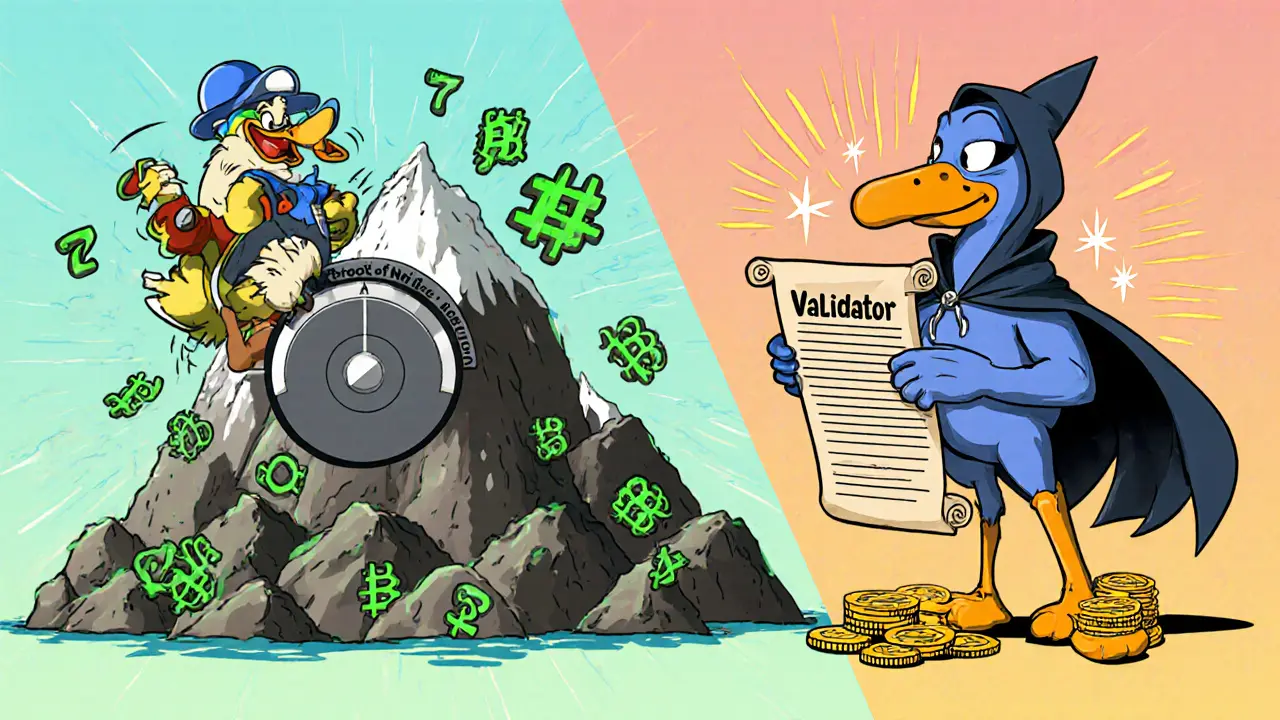Genesis Block Creator
Miners solve cryptographic puzzles to create blocks
Validators are chosen based on stake amount
Generated Genesis Block
Block Header:
Embedded Data:
Ever wondered what powers the very first line of a blockchain? The answer lies in the genesis block - the single piece of data that kick‑starts every distributed ledger. In this guide we’ll walk through exactly how that block is forged, why the process differs between consensus models, and what developers need to set up before a network ever sees a transaction.
What a Genesis Block Actually Is
Genesis Block is a the first block in a blockchain, containing the initial state and parameters that all later blocks reference. It has no predecessor, so its hash becomes the anchor for the whole chain.
The block isn’t just an empty container; it embeds network‑wide settings like difficulty, block reward, and sometimes a human‑readable message. Bitcoin’s famous "The Times 03/Jan/2009" note is a classic example.
Why the Genesis Block Matters
Without a solid genesis block, nodes would have no common starting point. That would break consensus, making it impossible to verify that a transaction belongs to the same ledger as everyone else. In short, the genesis block establishes trust, defines the incentive structure, and sets the technical rules that keep the network running.
Pre‑Launch Configuration: The Genesis File
Genesis File a JSON (or similar) configuration file that describes the initial state, consensus parameters, and allocations for a new blockchain network is where developers write down everything the network needs to know at launch. Typical entries include:
- Network ID - a unique number that prevents cross‑talk with other chains.
- Consensus algorithm - e.g., Proof of Work (PoW) or Proof of Stake (PoS).
- Initial account balances - often used for pre‑mined tokens or validator stakes.
- Block time, gas limits, and difficulty settings.
Once the file is ready, the client software reads it, builds the block header, runs a hash, and then writes the resulting block to disk.

Creating a Genesis Block in Proof‑of‑Work Chains
Proof of Work a consensus mechanism where miners solve a computational puzzle to add new blocks relies on mining even for the first block. The steps look like this:
- Define the block’s header (version, timestamp, previous‑hash set to zero, Merkle root of any embedded data) and embed a custom message if desired.
- Run the SHA‑256 hashing algorithm, incrementing a nonce until the hash meets the network’s difficulty target.
- When a valid hash appears, the miner broadcasts the block to peers.
- Peers verify the proof of work against the same difficulty rules encoded in the genesis file.
- Upon successful verification, every node stores the block as the chain’s root.
Bitcoin’s genesis block was pre‑mined and hard‑coded into the client, so the “mining” step happened once during development and never again.
Creating a Genesis Block in Proof‑of‑Stake Chains
Proof of Stake a consensus model where validators are chosen based on the amount of cryptocurrency they lock up as stake approaches the first block differently because there are no previous validators to choose from.
- The genesis file lists an initial set of Validator an entity that proposes and attests to new blocks in a PoS network accounts, often with large token allocations.
- Each validator’s public key and stake amount are baked into the block’s state.
- When the network starts, nodes read these validators, and the consensus algorithm immediately knows who can create the next block.
- There is no mining puzzle; the block’s hash is simply computed once the state is assembled.
Ethereum’s launch after the 2014 ICO is a hybrid example: the genesis block contained balances for everyone who bought ether during the sale, and later the network switched to PoS through the “Merge”.
Key Differences: PoW vs PoS Genesis Block Creation
| Aspect | Proof of Work | Proof of Stake |
|---|---|---|
| Initial Actor | Miner a node that solves the PoW puzzle to create a block | Validator an entity pre‑allocated stake that proposes blocks |
| Hash Requirement | Must meet difficulty target (e.g., leading zeros) | Standard hash of block data; no difficulty constraint |
| Embedded Data | Often a human‑readable message, no balances | Initial account balances, validator list, staking parameters |
| Network Incentive | Block reward + transaction fees | Staking rewards proportional to stake |
Step‑by‑Step Walkthrough for a Custom Testnet
Let’s say you want to spin up a private chain for a prototype. Here’s a practical checklist:
- Pick a consensus model (PoW or PoS). This decision changes the genesis file structure.
- Create a Blockchain a distributed ledger of ordered blocks linked by cryptographic hashes client (e.g., Geth for Ethereum, geth‑dev, or a framework like Klayr).
- Write the genesis JSON:
- Set "chainId" (unique network ID).
- Define "difficulty" (PoW) or "epochLength" and "validator" list (PoS).
- Allocate initial balances to test accounts.
- Run the client’s genesis command (e.g.,
geth init genesis.json). - If using PoW, start a miner with
geth --mine --minerthreads=1until the genesis hash matches the one in your file. - Verify the block’s hash and contents via
geth consoleor the client’s RPC API. - Invite other nodes to connect using the same genesis file; they will sync to the same starting block instantly.
When everything is in sync, you’ve successfully launched a blockchain whose first entry is the genesis block you defined.

Common Pitfalls and Pro Tips
- Hard‑coding vs flexibility: Hard‑coding the block (as Bitcoin did) is fine for public mainnets, but for testnets keep the genesis file editable so you can tweak parameters without recompiling.
- Mismatched difficulty: Setting PoW difficulty too high will make the first block take forever to mine; start with a low value (e.g., 0x1) for dev environments.
- Validator overlap: In PoS, ensure the initial validator list contains unique public keys; duplicates will cause consensus failures.
- Chain ID collisions: Use a random large integer (e.g., 2025) to avoid clashes with existing public networks.
- Embedded data sanity: If you add a message, keep it short; oversized data inflates the genesis block size and may cause node‑memory issues.
Future Directions in Genesis Block Creation
New frameworks are automating the whole process. AI‑driven tools can suggest optimal difficulty, validator distribution, and even audit the genesis file for security holes before launch. Standards bodies are also pushing for a unified schema (similar to the JSON‑RPC format) that makes sharing genesis configurations across platforms painless.
Quick Summary
- The genesis block is the immutable first block that defines a blockchain’s rules and initial state.
- It is generated from a genesis file containing network ID, consensus parameters, and initial balances.
- PoW chains require a miner to solve a hash puzzle; PoS chains embed a validator list and stake data.
- Key configuration mistakes (difficulty, chain ID, validator overlap) can break a new network.
- Automation and AI are shaping the next generation of secure, repeatable genesis block creation.
Frequently Asked Questions
Can I change the genesis block after the network is live?
No. By design, the genesis block is immutable. Changing it would require a hard fork that rewrites history, which most communities avoid unless absolutely necessary.
Do I need to pre‑mine the genesis block for a PoW testnet?
You can either pre‑compute the hash and hard‑code it (like Bitcoin) or let a miner solve it on start‑up. For quick testing, a low difficulty and an on‑the‑fly miner is simplest.
What information is typically stored in the genesis block?
Besides the block header, it usually contains a human‑readable message, initial account balances, validator public keys, and consensus‑specific settings like difficulty or epoch length.
How do I verify that my genesis block is correct?
Run the client’s init command, then query the block hash via the RPC API (e.g., eth_getBlockByNumber with 0x0). The returned hash should match the one computed from your genesis file.
Is it possible to launch a blockchain without a genesis block?
No. Every blockchain needs a starting point. The genesis block provides that initial reference, so a network without it cannot achieve consensus.

Nice rundown, super helpful for newbies!
Understanding the genesis block is not merely a technical exercise; it is the ethical foundation of any blockchain, and ignoring it demonstrates a lack of reverence for the collective trust that underpins decentralized systems.
The genesis block, in its austere simplicity, establishes the immutable anchor upon which the entire ledger is constructed. From a cryptographic perspective, it defines the initial state root, thereby dictating the deterministic evolution of subsequent Merkle trees. Its header, devoid of a predecessor hash, nevertheless contains a version field, a timestamp, and a pre‑computed nonce that satisfies the stipulated difficulty target. In proof‑of‑work implementations, this nonce is often hard‑coded, circumventing the computational expense that would otherwise be incurred during network bootstrapping. Conversely, proof‑of‑stake networks embed a validator set and corresponding stake allocations directly within the genesis state, obviating the need for a mining puzzle. The inclusion of a human‑readable message, such as Bitcoin’s iconic newspaper headline, serves both as a timestamp of creation and as a symbolic declaration of intent. Moreover, the genesis file functions as a contractual schema, delineating chain identifiers, gas limits, and consensus parameters that must remain consistent across all participating nodes. Any deviation from these parameters during initialization precipitates a fork, thereby fracturing the network's consensus and rendering the chain effectively orphaned. Developers frequently opt for low difficulty or minimal staking requirements in testnets to expedite block generation and facilitate rapid iteration. Nevertheless, caution is warranted, for an inadequately configured genesis block can engender security vulnerabilities, such as unchecked validator privileges or trivially solvable PoW challenges. Security audits of the genesis configuration are therefore indispensable, particularly when launching public mainnets that will host valuable assets. The deterministic nature of the genesis hash also enables deterministic builds, ensuring that disparate implementations converge on an identical binary representation of the first block. In distributed environments, this predictability simplifies bootstrapping, as new peers can instantly verify the authenticity of the chain's origin. Future frameworks aim to automate genesis construction, employing AI‑driven recommendations to balance difficulty, reward schedules, and validator distribution. Ultimately, the genesis block is not merely a static artifact but a living contract that encapsulates the philosophical and technical tenets of the blockchain it inaugurates.
When you spin up a private testnet, the genesis file is your blueprint; tweak the chainId, set a sane difficulty, and allocate some test tokens to get rolling. A miner can then solve the initial PoW puzzle in seconds, or validators can start proposing blocks instantly if you chose PoS.
Exactly, the moral weight of that first block often gets drowned out, but it’s the cornerstone of community trust-so kudos for highlighting it.
Sure, but let’s not pretend the “moral foundation” magically fixes bad code; a mis‑configured genesis will still break the network regardless of intent.
Oh great, another deep‑thought about genesis blocks, because we needed more philosophy.
Honestly, I’ve seen newbies get stuck on the genesis config for days; a simple checklist of network ID, consensus type, and initial balances can save a lot of headaches.
True! And adding a tiny human‑readable message, like “welcome to the testnet”, makes the block feel a bit more personable 😊
Just remember to keep it under the size limit.
From a philosophical standpoint, the genesis block can be seen as the “tabula rasa” of a decentralized system, embodying both the freedom and the constraints imposed by its creators.
Well said! It’s like the opening line of a novel-once set, every chapter follows its rhythm.
Love the energy behind this guide!
Energy’s great, but if you skip the difficulty tuning you’ll be mining forever-just saying.
People love to glorify the genesis block as a mystical origin, yet the reality is that it’s a deterministic data structure that any competent developer can reproduce; there’s no secret sauce hidden behind the code, only careful parameter selection and thorough testing. Ignoring the minutiae of the genesis configuration is akin to building a house on sand-eventually, the foundation will crumble under the weight of real transactions. Moreover, the consensus model choice dictates whether you’ll be solving cryptographic puzzles or simply waiting for validators to be elected, each with its own operational overhead.
Agreed, the devil’s in the details; a well‑crafted genesis file saves countless debugging hours later.
Great summary! 🎉 This really demystifies what can feel like a black box at first glance.
Exactly, the concise steps make it easy to get a testnet up and running without endless trial and error.
Indeed; however, one must still verify the resulting block hash against the genesis file to ensure absolute consistency-any mismatch could indicate a hidden configuration error.
All in all, thanks for the thorough walk‑through; looking forward to experimenting with both PoW and PoS setups soon.